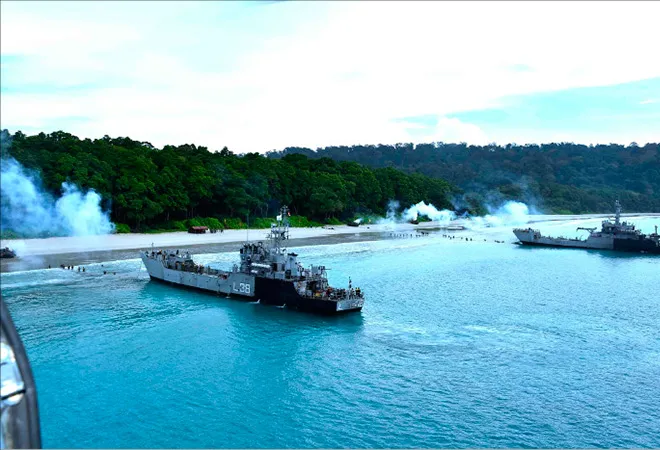The Ladakh stand-off with China has catalysed India’s efforts to strengthen its military presence at the Andaman and Nicobar Islands (ANI). New Delhi recently moved to expedite plans for basing additional military forces, including facilities for additional warships, aircraft, missile batteries and infantry soldiers at the strategically-located Andaman Islands. Naval air stations INS Kohassa in Shibpur and INS Baaz in Campbell Bay are reportedly having their runways extended to support operations by large aircraft, even as a 10-year infrastructure development “roll-on” plan — pegged at Rs 5,000 crores — is on the fast-track. Indian strategic commentators are even urging New Delhi to permit friendly foreign navies access to the ANI’s military bases.
The idea of militarising the Andaman Islands isn’t new. Since the 1980s, Indian commentators have advocated building strategic muscle at the ANI. What has often seemed like a straightforward choice for Indian policymakers, however, has never been an easy decision to make. On the matter of the strategic development of the Andamans, India’s defence and foreign policy establishments have not always been on the same page. A section of India’s diplomatic community has opposed militarising the ANI, arguing that turning the islands into a strategic-military garrison would militarise the littorals — an outcome that would not sit well with countries in South and Southeast Asia.
When India first began developing the ANI in the mid-1980s, observers say Malaysia and Indonesia had been wary. Jakarta and Kuala Lumpur feared that India would use its military facilities in the ANI to dominate its region, and project power east of Malacca. In time, New Delhi’s willingness to keep its security presence at the strategic islands to a minimum assured many in Asia that its motives were benign. Today, amid growing threats from China, New Delhi seems open to the idea of militarising the islands. But, many say opening up the ANI’s military facilities to foreign navies could still spook regional states.
When India first began developing the ANI in the mid-1980s, observers say Malaysia and Indonesia had been wary. Jakarta and Kuala Lumpur feared that India would use its military facilities in the ANI to dominate its region, and project power east of Malacca
There is also an ecological aspect to militarising the ANI. Since 2015, when the government had first announced its intention to transform the islands into a maritime hub — allocating Rs 10,000 crores for the purpose — efforts to promote tourism and port development have hugely expanded. To improve tourism and trade potential, Niti Aayog has a plan to construct hotels, resorts and a trans-shipment hub at Campbell Bay. The flurry of recent infrastructure projects, environmentalists warn, could devastate the fragile ecology of the Andaman. Already many islands are facing significant damage from the climate crisis.
The proponents of the Andaman’s militarisation point to a different kind of asymmetry: The apparent lack of reciprocity in India’s bilateral logistics agreements. The Indian navy’s plans to offer logistical support to partner navies does not, ostensibly, include its ANI facilities. Four years after signing a logistics pact with the United States (US), its navy ships still have no access the ANI. France, Singapore and Australia — India’s other logistics partners — too haven’t had their warships repaired or replenished at Indian island facilities. With New Delhi unwilling to open up its island bases to foreign warships, observers say India’s logistics arrangements haven’t performed to potential. To counter China’s expanding footprint in India’s sphere of maritime interest, militarisation advocates aver New Delhi must permit Japan, Australia and France and the US to build strategic capabilities at the ANI.
In the past, Indian policymakers have considered cooperative avenues with Indo-Pacific partners. In 2016, New Delhi and Tokyo discussed a joint project to upgrade infrastructure in the ANI, including a proposal to install a sound surveillance sensors (SOSUS) chain to improve India’s underwater domain awareness. The plan was to integrate India’s undersea sensor chain with the existing US-Japan “Fish Hook” SOSUS network meant specifically to monitor People’s Liberation Army-Navy(PLAN) submarine activity in the South China Sea and the Indian Ocean Rim.
In 2016, New Delhi and Tokyo discussed a joint project to upgrade infrastructure in the ANI, including a proposal to install a sound surveillance sensors (SOSUS) chain to improve India’s underwater domain awareness
But, notwithstanding its utility in detecting Chinese submarines, a region-wide undersea chain of sensors has implications that call for a degree of caution. In particular, Delhi needs to consider the possibility that operating sensitive equipment with foreign partners might involve sharing of critical undersea’ data with foreign collaborators. The Japan-US SOSUS provides some useful pointers. While the Japanese Maritime Self -Defence Force (JMSDF) and US Navy personnel jointly manage the JMSDF Oceanographic Observation Centre in Okinawa, the information is available to the US Pacific Command, and the facility is controlled by the US Navy. Needless to say, an Indo-Japanese-US project in the Andaman Sea might require a level of informational access that the Indian Navy may not be comfortable with.
While China’s presence in the Indian Ocean is growing, Beijing hasn’t so far militarised key Belt and Road Initiative (BRI) outposts in the Bay of Bengal (Hambantota, Chittagong and Kyaukpyu). In recent weeks, as Indian warships have held exercises with the US and Japanese navy in the Indian Ocean, New Delhi’s resolve to counter China in its maritime backyard has been amply evident. If New Delhi pushes for greater military presence in the ANI, Beijing could well seek military access in friendly Bay countries.
This isn’t to suggest that inviting foreign navies to the ANI or joint military projects in the Andaman sea is a bad idea. Strengthening collaboration with Indo-Pacific partners at the ANI is very much an option for Indian decision-makers to consider. But New Delhi must also take into account the downsides of offering foreign navies access to its island facilities. The final decision should be based on a dispassionate weighing of costs and benefits.
This commentary originally appeared in Hindustan Times.
The views expressed above belong to the author(s). ORF research and analyses now available on Telegram! Click here to access our curated content — blogs, longforms and interviews.




 PREV
PREV


